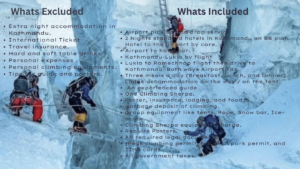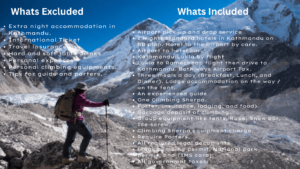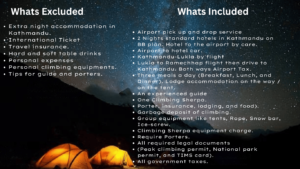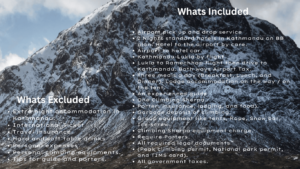Island Peak Climbing Cost | Season To Climb Island Peak | Island Peak Trek
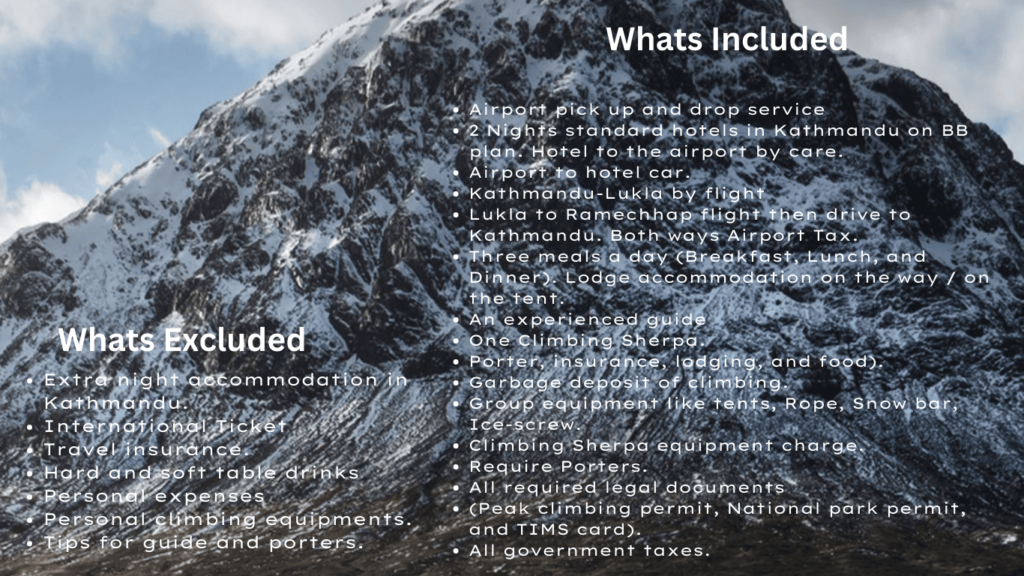
Island Peak Climbing Cost: $2950
Island Peak climbing cost is $2950. It varies depending on several factors. There are costs associated with climbing Island Peak. Permit fees, transportation, food accommodation, trekking & climbing guide, and porter are a few of them.
7 February to 28 February
7 March to 29 March
6 April to 27 April
20 April to 11 May
1 November to 22 November
Island Peak Trek
After flying to Lukla, you’ll trek down through pretty forests to Phakding Zamfute, at 2650 meters (8700 feet), and stay in the lovely guesthouse on the side of the Dudh Khosi River.
You need to trek through picturesque villages. Climb a large hill up to Namche Bazaar; along the way, cross the Dudh Khosi and Bhote Khosi rivers.
Namche is the main commercial town of the Khumbu Valley, at 3440 meters (11,250 feet), where we will stay in the very pretty Lodge.
Rest in Namche and enjoy an acclimatization walk to the hotel for fine views of Ama Dablam and Everest, then head downtown for apple pie and cappuccinos.
Walk along ridges above the Dudh Khosi River with stunning views of Mt. Thamserku. Drop down to the river, then walk up another large hill to Tengboche, then descend to Deboche, cross the river again, and traverse the ridges up to the village of Pangboche at 3950 meters (13,000 feet), where we stay in the lovely lodge.
Walk for 3.5 hours, branching off onto the Imja River, coming to the busy little town of Dingboche, which is an agricultural and trekking center. We will stay in Dingboche at 4400 meters (14,400 feet).
Island Peak Climb
While climbing Island Peak in Nepal first, you will be following an easy trail up a gentle slope. After a time, you will walk up a rocky gully.
Then, you will traverse across a slope, following trails on rock ledges along the contour of the ridge. You will hike over a few ledges and then turn to hike uphill along some rocky ridges that go up.
Finally, you will come to a few rocky outcrops and then to some bigger flat spots and plateaus in the ridge. In some small rock towers in one of these, you will put on your harness, big mountain boots, and crampons. Thus, this spot is called the “crampon point”.
After taking a break, drinking, and eating, you will set off for the Island Peak Glacier, walking roped together with your Sherpa. After some flat snow walking on a good path across the glacier, you will come to a few crevasses that you will walk around while roped to your Sherpa.
You will walk down into some small glacial valleys, cross over, and then hike up some snowy ridges. Sometimes there may be an aluminum ladder lashed in place to assist you. After crossing through this crevassed section, you will head up a long, gentle snow slope to the base of the “headwall” and take a nice rest break, eating food and drinking a lot of liquid.
Then you will begin climbing the fixed ropes up this steep snowy section, using your ascender, ice axe, and safety line, which you practiced with in basecamp. After climbing to the top of the snow face, you will clip to the safety rope and walk along a snow ridge, which can be wide in some places and also may be narrow in some spots.
Finally, the ridge reaches a high point, and you will be on the summit of Island Peak, at 6189 meters (20,300 feet) high. The views are amazing here. You can see Ama Dablam, Lhotse South Face, Nuptse, Makalu, Baruntse, Mera Peak, and many others. Climbing Island Peak is a very good achievement. Well done!
Best Time To Climb Island Peak Nepal
Island Peak can be climbed any time of the year but we run climb and the best time to climb Island Peak are in the following months:
March
April
May
November
February
How To Reach Island Peak
You need to fly to Nepal’s capital city, Kathmandu Airport.
I woke up early the next morning and boarded a bus from the hotel to the Kathmandu Domestic Airport. Sometimes the Kathmandu airport is busy, so we have to drive for 4 hours to a regional airport that specializes in flights to Lukla.
In either case, it takes about 30 minutes to fly to Lukla on a 16-seat propeller plane. Your luggage will fly with you. If the weather is good, you can see lots of mountains during the flight, including a glimpse of Everest.
Equipment Required To Climb Island Peak
- Clothing includes shirts, socks, and trousers underwear
- For outer layers medium weigh gloves
- Snow boots with crampons
- Warm hat
- Sun goggle is r
- equired to tackle snow as
- Warm thick down jacket both windproof and waterproof along with the hood
Here is the list of the items required:
- An ice axe
- Harness
- Helmet
- Sleeping mats (can be purchased in Lukla)
- Sleeping bag
- 3 water bottles (one lite reach)
- 50-liter rucksack
- Figure 8 descender
- Ascender
- 4 slings
- 4 standard carabiners
- 2 locking carabiners
We will provide you with group equipment. Some of them are:
- Tents
- Ropes
- Stoves
- Food
- Hot drinks
FAQ
What can be experienced on Island Peak?
Ascending Island Peak offers a glimpse into the exciting world of Himalayan climbing. It begins with a thrilling flight to Lukla, known for having one of the most captivating airports worldwide. From there, the journey continues with a trek through various villages in the Khumbu Valley, allowing for an immersive experience of the local culture. Along the way, breathtaking vistas of prominent peaks such as Mount Everest, Lhotse, and Ama Dablam await, mesmerizing climbers with their grandeur. The highlight of the expedition is a day of classic Himalayan climbing, navigating across a glacier and scaling a steep headwall to reach a small summit that offers awe-inspiring panoramic views. Island Peak serves as an exceptional introduction to the world of Himalayan climbing, combining relatively manageable yet exhilarating ascents, the renowned Nepali culture, and some of the most magnificent vistas on the planet.
What permits are necessary for climbing Island Peak?
Climbing Island Peak necessitates obtaining three permits: the Khumbu Pasang LhamuRural Municipality Permit, the Sagarmatha National Park Entry Permit, and a climbing permit.
Why is Island Peak the most sought-after destination for peak climbing in Nepal?
Island Peak has gained immense popularity due to various factors. One of the main reasons is its convenient accessibility from the renowned Khumbu Valley, which treats visitors to breathtaking views of Everest, Lhotse, Ama Dablam, and numerous other majestic peaks. Moreover, when compared to other Himalayan mountains, Island Peak is relatively easier to climb. It serves as a perfect starting point for many climbers venturing into Nepal’s mountainous terrain, making it their inaugural conquest.
When is the ideal time to embark on an expedition to Island Peak?
Similar to most mountains in Nepal, the optimal period for ascending Island Peak is during the spring season (April/May) or the autumn season (October/November).
What sets Mera Peak apart from Island Peak when it comes to climbing?
The difficulty level, time commitment, and cost of climbing both Mera Peak and Island Peak are quite similar. However, Mera Peak and Island Peak have few key differences. Mera Peak stands at almost 1,000 feet higher than Island Peak, but it is considered to be a slightly less technical climb compared to its counterpart. Island Peak, on the other hand, is situated in the well-known Khumbu Valley, while Mera Peak is located in a much less frequented valley. Both mountains provide breathtaking views of Everest and the surrounding area, making them appealing options for beginner climbers.
For someone who has never attempted a climb before, how feasible is it to conquer Island Peak?
Island Peak is often recommended as one of Nepal’s more beginner-friendly climbs. The route itself is not excessively challenging in terms of technical difficulty. However, it is crucial not to underestimate the climb despite its classification as “easy.” Standing at an elevation of 20,305 feet, Island Peak poses significant challenges due to the high altitude and cold temperatures. Even climbers who are in good physical condition should be prepared for the demanding nature of this ascent. With proper preparation and determination, most climbers have the potential to reach the summit of Island Peak.
